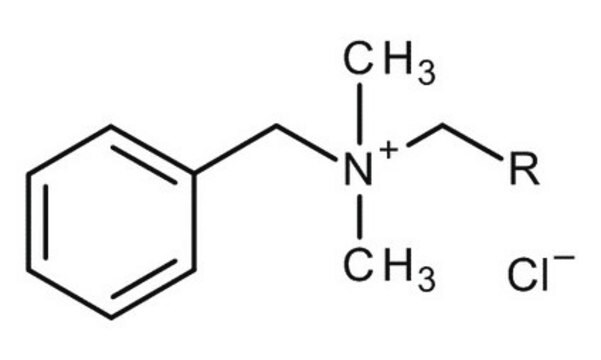B6295
Benzalconio cloruro
BioXtra
Sinonimo/i:
Alchildimetilbenzilammonio cloruro
About This Item
Prodotti consigliati
Descrizione
cationic
Nome Commerciale
BioXtra
Saggio
95.0-105.0% (calculated on dry substance)
Stato
(Solid or Semi-Solid or Viscous Liquid)
Impurezze
≤0.001% Phosphate
≤0.1% Insoluble matter
≤10% water
Residuo alla calcinazione
≤2%
Anioni in tracce
sulfate (SO42-): ≤0.05%
Cationi in tracce
Al: ≤0.0005%
Ca: ≤0.0005%
Cu: ≤0.0005%
Fe: ≤0.0005%
K: ≤0.005%
Mg: ≤0.0005%
Na: ≤0.02%
Pb: ≤0.001%
Zn: ≤0.0005%
Stringa SMILE
[Cl-].CCCCCCCCCCCCCC[N+](C)(C)Cc1ccccc1
InChI
1S/C19H34N.ClH/c1-4-5-6-7-8-9-10-14-17-20(2,3)18-19-15-12-11-13-16-19;/h11-13,15-16H,4-10,14,17-18H2,1-3H3;1H/q+1;/p-1
TTZLKXKJIMOHHG-UHFFFAOYSA-M
Cerchi prodotti simili? Visita Guida al confronto tra prodotti
Descrizione generale
Applicazioni
Esclusione di responsabilità
Avvertenze
Danger
Indicazioni di pericolo
Consigli di prudenza
Classi di pericolo
Acute Tox. 4 Dermal - Acute Tox. 4 Oral - Aquatic Acute 1 - Aquatic Chronic 1 - Eye Dam. 1 - Skin Corr. 1B
Codice della classe di stoccaggio
8B - Non-combustible corrosive hazardous materials
Classe di pericolosità dell'acqua (WGK)
WGK 2
Punto d’infiammabilità (°F)
Not applicable
Punto d’infiammabilità (°C)
Not applicable
Dispositivi di protezione individuale
Eyeshields, Faceshields, Gloves, type P3 (EN 143) respirator cartridges
Scegli una delle versioni più recenti:
Possiedi già questo prodotto?
I documenti relativi ai prodotti acquistati recentemente sono disponibili nell’Archivio dei documenti.
I clienti hanno visto anche
Il team dei nostri ricercatori vanta grande esperienza in tutte le aree della ricerca quali Life Science, scienza dei materiali, sintesi chimica, cromatografia, discipline analitiche, ecc..
Contatta l'Assistenza Tecnica.







